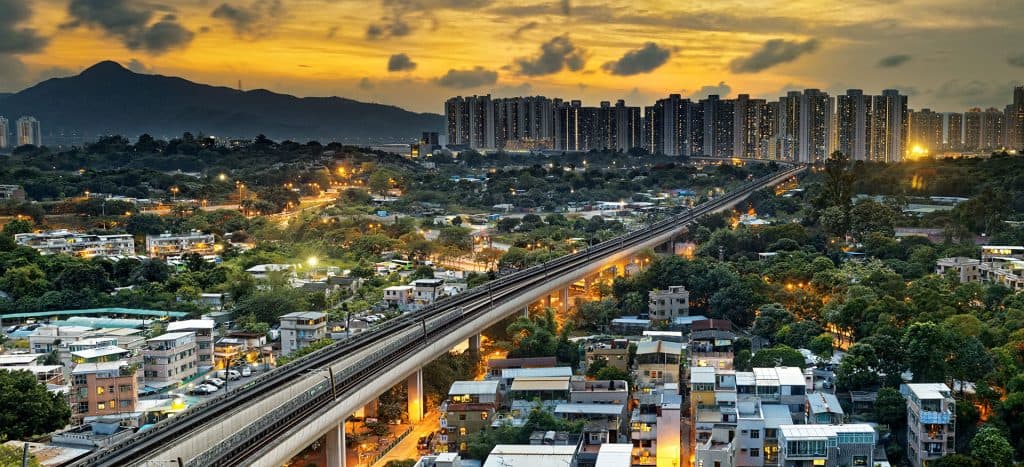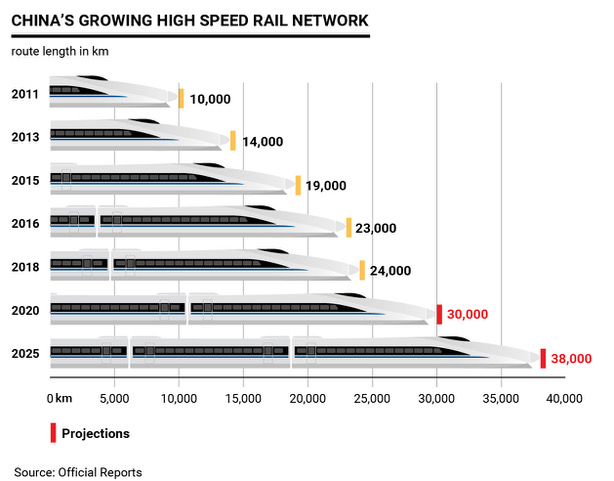
The Chinese high-speed rail network is now one step away from reaching 30,000 kilometers, thus strengthening China’s world leadership in terms of extension. A result achieved by investing an average of $100 billion a year.
Beijing and Tianjin, Shanghai and Nanjing, Changsha and Guangzhou: China’s largest cities are now connected by high-speed rail.
China’s vision for its future transportation includes sustainable mobility through urban subway lines and high-speed rail links between one city and another. As a result, China now has the world’s largest high-speed rail network: it will reach 30,000 kilometres (18,641 miles) by 2020, according to the International Union of Railways and the South China Morning Post newspaper. That’s after China completes the construction of around 3,200 kilometres (1,988 miles) of high-speed lines now being built. It had 29,000 kilometres (18,019 miles) of high-speed lines at the end of 2018.
China’s high-speed rail network is not only the world’s largest. It continues to grow by adding new routes and testing new, faster train prototypes that — at least so far — have already exceeded speeds of Japan’s Shinkansen, historically the world’s fastest train.
China achieved these results in just 20 years, during which it moved from design to completion of a far-flung high-speed interurban transport system. Here is a look at the timeline, starting from the late 1990s.
1997 – 2008: the first high speed train in China
During the 1990s, China enjoyed an economic boom. An increasingly affluent population flocked to the country’s largest cities, which started to become the megalopolises we know today. This led to a growing demand for fast and efficient transport – especially over the long distances common in this massive country — to respond to the changing needs of the population. The state embarked on a plan to modernize the existing railway network with the aim of bringing the most crowded sections up to a speed of 160 km/h (90 mph). Construction of the country’s first high-speed line with trains reaching up to 350 km/h (217 mph) began in 2005, which was inaugurated in August 2008, connecting the capital Beijing with Tianjin in about 30 minutes. It is still in operation.
2008 – 2013: the development China’s high speed rail network
After the inauguration of the country’s first high-speed line, investments in the sector focused on other strategic links bringing its far-flung regions within closer reach. The line connecting Shanghai, Wuhan and Chengdu was created during this five-year period, joining the country’s east and west. This complex project was completed in stages between 2008 and 2013, cutting end-to-end travel times from a previous 40 hours to as little as 11 hours. Another line was constructed during this same period that passed through Shanghai, crossing the country from north to south and connecting the two great Chinese rivers, the Yangtze and the Pearl, in less than 11 hours. In 2011, the line connecting Beijing to Shanghai became the country’s most crowded. In 2017, on the sixth anniversary of its opening, the Chinese authorities reported that it had been used by 630 million people that year.

2013 – 2019: the construction of new railway lines
Work began on the construction of several other railway lines during this period. One of the most important connects Beijing with Hong Kong, inaugurated in September 2018 and cutting travel times to under 10 hours from a previous 24.
The line connecting Hong Kong with Guangzhou, the third largest city in the country, was also inaugurated in 2018. The trip takes just 50 minutes.
Construction shows no signs of stopping. In 2019, a line from Beijing to Harbin (a city in the northeast) began service, cutting travel times to just 7 hours.
The race towards the future
The race that began 20 years ago seems to have no finish line in sight, and the Beijing government has confirmed it will continue investing in sustainable mobility and in particular in high-speed rail as one of the country’s main means of transport. South China Morning Post reported that the China Railway Corporation (the state-owned company that manages rail network construction) intends to invest in 6,800 kilometers of new railway track in 2019, 45% more than in 2018, of which at least 3,200 will be high-speed lines.
This strategy is driven by the Chinese government’s awareness of the importance of the infrastructure network as a driving force necessary to ensure strong and continued GDP growth.
In 2018 alone the government has allocated $106.3 billion for the development of the country’s rail network ($550 billion in the 2016-2020 five-year period), 61.5% more than in 2008 when the marathon began.
The fastest train in the world
Speed is everything in China’s railway infrastructure development plan. The network will be increasingly extensive, but also fast, crossed by trains able to reduce travel times to the maximum. Tests on a new model of magnetic levitation train designed to float on a single track capable of reaching 600 km/h (372 mph) speeds are currently being carried out in the city of Qingdao.
The China Railway Rolling Stock Corporation, another state-owned company, aims to begin manufacturing the train as early as 2021. If it succeeds, the train would beat Japan’s record for the Shinkansen, which today shoots between Tokyo and Osaka at 505 km/h (313 mph).

